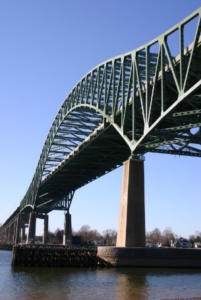Ever wonder how much it would take to make all of America’s bridges safe and in good repair? Spoiler alert – it will require billions.
A recent study released by the Federal Highway Administration (FHWA) reports that $48 billion will be required just to replace and/or rehabilitate National Highway System bridges currently classified as “structurally deficient.”
However, the FHWA is no longer just raising alarms about the critical state of America’s bridges, the agency is providing funding to address the needs. Current funding will represent America’s largest investment in bridge infrastructure since the creation of the U.S. Interstate system in 1956.
Early this year, the FWHA announced it was authorizing $1 billion to support four significant bridge projects. More than half of the funding ($1.4 billion) is tagged for construction of the Brent Spence Bridge that connects Ohio and Kentucky. A grant of $400 million will fund improvements to San Francisco’s iconic Golden Gate Bridge and $144 million was allocated for the rehabilitation of four bridges that cross the Calumet River in south Chicago.
The most recent funding announcement marks the first annual round of Large Bridge Project Grants which received funding from the Infrastructure Investment and Jobs Act (IIJA). Over the next five years, the FHWA will award a combined $12.5 billion for projects to repair or replace structurally deficient bridges.
More recently, the agency announced another $300 million for 12 more bridge projects. This recent round of funding emphasizes the role of bridges in bolstering local community connectivity. In broad terms, these grants will be used to modernize bridges of various sizes to ensure that commuters, first responders, commercial vehicles and school buses can traverse bridges safely. A grant allocation of $73 million is earmarked for Michigan’s replacement of a bridge that has serviced the Great Lakes region since it opened 85 years ago. Another award of approximately $70 million will support the rebuilding of a bridge that facilitates travel between the state of Virginia and Washington D.C. A lesser amount of $14 million will go to the Texas Department of Transportation to replace a bridge that spans the San Antonio River.
This bridge funding will extend to nearly every part of the country. It will be used to modernize structures that for decades have been critical components of the national economy. Most projects will require new construction bridge technology. In recent years, building information modeling (BIM) software, which uses data to streamline virtually every stage of construction, has been adapted to the more nuanced framework of bridge construction. Similarly, technologies such as artificial intelligence, virtual reality, inspection drones, LiDAR and GPS are also being integrated into new bridge projects.
The Pennsylvania Turnpike Commission (PTC) and the New Jersey Turnpike Authority (NJTA) will launch preliminary engineering work on a new bridge designed to carry commuters across the Delaware River. The project will replace the existing Delaware River Turnpike Bridge that stretches from Burlington County, N.J., to Bucks County, Pa. Despite dating back to the 1950s, the bridge has continued to play an integral role in the broader highway system that links Philadelphia and New York City. Efforts to replace it have taken on greater urgency in recent years because one of its support beams has begun to fracture. PTC and NJTA will split the cost of the project to ensure a construction start in 2025. Costs for the project will likely exceed $1 billion.
Officials with the Florida Department of Transportation will soon replace a drawbridge that connects a span of the Intracoastal Waterway between the municipalities of Cortez and Bradenton Beach. The mega bridge project was included in the state transportation department’s five-year work program, which received approval from state officials last year. Additionally, the state allocated $77 million for the project.
The Ohio Department of Transportation will oversee a project in Cincinnati that will replace the existing Western Hills Viaduct at a cost of approximately $400 million. State transportation officials are also working on another initiative to build connections from the new bridge to Interstate 75. The cost projections for that project are $170 million.
A recent FHWA award of $300 million for bridge improvements includes an allocation of $21 million to restore the Castleton-on-Hudson Bridge in Albany County, N.Y. The 63-year-old bridge accommodates 17,000 vehicles daily and is a major transportation corridor between the states of New York and Massachusetts. A recent federal grant for the bridge restoration work will offset costs for the second half of the plan, which includes projects to resolve safety and logistical issues associated with the bridge’s deteriorating condition. A construction contract for this phase of restoration work will go to bid in 2024.
Oregon and Washington transportation officials are partnering to modify the design of a multi-billion-dollar bridge replacement project. The project involves the existing Interstate 5 bridge which carries vehicles over the Columbia River and links major economic hubs in both states. Following input from the U.S. Coast Guard in February, officials began working on a design alternative for the bridge that includes a moveable span that allows it to function as a drawbridge to ensure safe passage of ships on the Columbia River. Because of inflation and other issues, the design shift has led to a 56% increase in the project’s budget – now estimated at between $5 billion and $7.5 billion.
The Bridge of the Americas in El Paso, one of the city’s four US-Mexico border crossings, will be the target of a major modernization effort. Originally built in 1967, the bridge now supports a daily average of 12,500 passenger vehicles, 600 commercial vehicles and 2,500 pedestrians. The outdated structural design causes considerable congestion as it spills over onto the surrounding highway system. Officials will select a preferred design alternative for the $650 million project by the end of this summer.
The new bridge funding will open up an abundance of contracting opportunities for planning, architectural, engineering, construction, technology and landscaping firms…not to mention all of the ancillary services and equipment that will be required.








